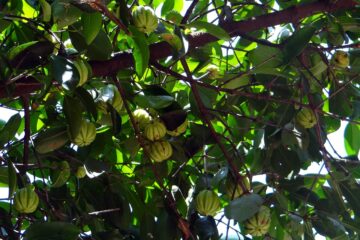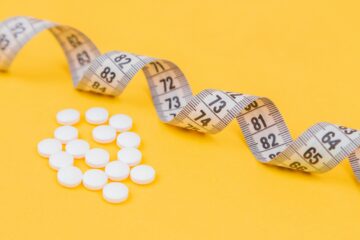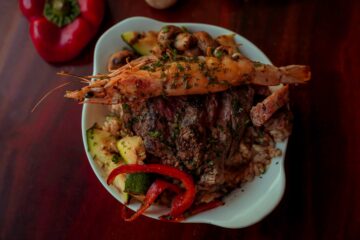The Dukan diet is a dietary plan that is similar to the Ketogenic diet and Atkins diet as they all emphasize consuming as much fat and protein as you like, as long as you avoid carbohydrates. It focuses on natural food rather than packaged food, and it encourages daily exercise. There are four Dukan Diet Phases, where each phase has its own goal; also the food amount is different from one phase to another.
The Dukan diet is known as “the French medical solution to permanent weight loss”, where there are only 72 to 100 food to choose from throughout the four phases of the diet. Keep in mind, Carbohydrates are the enemy, even if they are dressed as fruit and vegetables.
The diet is based on the theory that eating lots of protein can help the person lose weight that is because eating protein will help you feel full, high protein food is lower in calories, where your body will use more energy to digest the protein, thus it will lead to more calories being burned. Avoiding carbohydrates will force your body to use your body fat as energy. Also, it claims that it can help the person lose weight quickly without being hungry.
In this post, we will talk about the 4 phases of the Dukan diet, and what kind of food can or can’t eat in each phase.
The Dukan Diet attack phase
The attack phase consists of eating all the lean protein that you can handle, and 1.5 tablespoons of Oat bran which is very high in fiber, and high fiber food help the person suppress hunger. The main aim of this phase is rapid weight loss, where the theory is eating a high quantity of protein-rich food will kick start the metabolism.
On the other hand, dietitians say that no particular food can kick start the metabolism, but exercising can boost it, and it is a good thing that this diet encourages exercising on daily basis. Also, in this phase, the amount of water that you are allowed to drink every day is 6 cups. This phase lasts for around 9-11 days whether you need more than that or not depends on your own goals. Let’s say you are aiming to lose 40 pounds, then you will need to stay in this phase longer.
There are many sources of lean protein such as beef, fish, chicken, eggs, cottage cheese, fat-free dairy, and soy. You can eat as much as you want and one good thing about this diet is that you do not need to count your calorie intake. But you should make sure that all your choices are low in fat and contain no added sugar.
What Can You Eat?
1- All types of lean meat like beef, Lamb, and any other red meat
2- Chicken, fish, and shellfish
3- For vegetarians, you can find lean protein from soy, tempeh, tofu, and seitan
4- Fat-free dairy like cream cheese, milk, Greek yogurt, cottage cheese, and sour cream
5- 6 cups of water daily
6- 5 tablespoons of oat bran
7- shirataki noodles because they are calorie- and carb-free
What Do You Need to Avoid?
1- All types of Fruits
2- All types of Vegetables
3- Carbohydrates and grains except for Oat bran
4- Sugar
5- Alcohol
6- fat
Remember: this phase is where you start your exercise routine of 20 minutes each day.
The Dukan Diet Cruise Phase
This phase’s main goal is to lower the person’s body weight gradually by adding non-starchy vegetables to the person’s eating plan. Non-starchy vegetables are vegetables that contain a lower proportion of carbohydrates and calories compared to their starchy counterparts.
Since you will be eating unlimited amounts of lean proteins and non-starchy vegetables in this phase, it is recommended that you alternate between pure protein days and protein-plus vegetable days. Also, the diet requires that you eat 2 tablespoons of oat bran and exercise for 30-60 minutes each day.
It takes 3 days to lose one pound in this phase, which means that the length of the phase can run anywhere from 1-12 months depending on how much weight you want to lose.
What Can You Eat?
1- All types of lean meat like beef, Lamb, and any other red meat
2- Chicken, fish, and shellfish
3- For vegetarians, you can find lean protein from soy, tempeh, tofu, and seitan
4- Fat-free dairy like cream cheese, milk, Greek yogurt, cottage cheese, and sour cream
5- 6 cups of water daily
6- 5 tablespoons of oat bran
7- shirataki noodles because they are calorie- and carb-free
8- Non-starchy vegetables, like leafy greens, mushrooms, onions, and broccoli
What Do You Need to Avoid?
1- All types of Fruits
2- Starchy vegetables, like potatoes and corn
3- Carbohydrates and grains except for Oat bran
4- Sugar
5- Alcohol
6- fat
The Dukan Diet Consolidation Phase
The main goal in this phase is to avoid regaining any weight, where the person will be allowed to introduce some starchy food. You will be eating lean proteins and non-starchy vegetables but will be adding some carbs and fats. Also, there will be one day of lean protein only each week.
Your oat bran serving stays at the same 2 tablespoons per day, and you are required to exercise 25 minutes each day in the phase
What You Can Eat?
1- One to two servings of fruit per day except those listed below
2- Two slices of whole grain bread per day
3- Two servings of starchy food per week (make sure you eat 1 cup only when cooked)
4- Five ounces of hard rind cheese
5- Two celebration meals per week (one serving only of each: appetizer, dessert, and dessert)
6- 2 tablespoons of oat bran
What Do You Need to Avoid?
1- Sugar
2- Cherries
3- Alcohol (other than the one glass of wine in the celebration meals)
4- Bananas
5- Grapes
6- Figs
The Dukan Diet Stabilization Phase
This is the last phase, and it is a long-term maintenance part of the diet plan. It lasts indefinitely and its main goal is to help you keep the weight off. This phase is similar to Consolidation, the only difference is that it allows you to be a little looser with carbs and fats.
This phase is meant to become part of the person’s lifestyle, but there are a few things that you should be doing namely:
1- Eating 3 tablespoons of oat bran each day
2- Have a pure protein day every week
3- Make sure that you drink 1.5 l of water daily
4- Exercise every day for 20 minutes
You will not lose or gain weight during this phase since it is a long-term maintenance part of the diet plan. It is recommended that you practice some fitness habits like using stairs instead of elevators. Also, taking multivitamins with minerals is recommended.
What You Can Eat?
1- One to two servings of fruit per day except those listed below
2- Two slices of whole grain bread per day
3- Two servings of starchy food per week (make sure you eat 1 cup only when cooked)
4- Five ounces of hard rind cheese
5- Two celebration meals per week (one serving only of each: appetizer, dessert, and dessert)
6- 3 tablespoons of oat bran
What Do You Need to Avoid?
There are no foods that you should avoid, but you need to monitor the amount of food you consume
Conclusion
Experts always caution against certain high-protein diets because there is not enough research on the long-term effects they might have on your body. The studies that are available only focus on the short-term result without taking the overall health into consideration.
So, it is important that you talk to your physician or dietitian before you go on this diet or any other diet. Maybe there are other diet programs that might be more suitable for your weight loss goals. And will not have a bad effect on your health.
No matter what type of diet it is, never ever go on it until you talk to experts or your physician.
There Are Other Options To Lose Weight
This is not the only way to change your diet and alter your lifestyle to help you lose weight and live a healthy life, there are other options to lose weight whether physical activity or other types of diets.
You may find other leaflets in this series helpful, including:







0 Comments